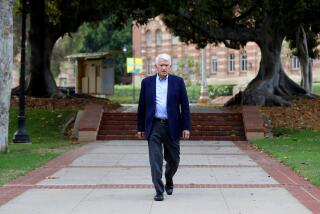Slightly Radioactive Reactor Block Removed From Wildlife Shelter
- Share via
A huge concrete block, used as shielding for a nuclear reactor at UCLA and then donated to an animal refuge in Little Tujunga Canyon, has been hauled back to the university following discovery of elevated radioactivity in the concrete, according to a UCLA report to the U.S. Nuclear Regulatory Commission.
University officials said radiation in the block exceeded the amount existing naturally in soil but was well below NRC safety limits.
In a Jan. 11 report to the NRC, they said the block was removed “in order to eliminate any concern” at the Wildlife Waystation, a shelter east of Sylmar that cares for dangerous and exotic animals.
Radioactivity in 19 other concrete blocks that were donated to the shelter was measured at or below the level of natural background radiation, according to survey data gathered by UCLA officials last month.
However, no tests were performed on two of the giant blocks that were buried at the shelter as part of an erosion control project, according to the report. University officials said they are confident these blocks are not contaminated because they had been located farther from the reactor core than other blocks that were found to be uncontaminated.
Greg Cook, a spokesman for the NRC’s western regional office in Walnut Creek, said agency officials concur with that assessment. There is “no likelihood at all that those other blocks exceed the surface contamination limits,” Cook said.
James E. McLaughlin, radiation safety officer at UCLA, said the block hauled back last month from the shelter to the old reactor building on the Westwood campus will be disposed of during the next few months with other reactor scrap.
The blocks were tested in December because UCLA had no records to show that it took all required radiation measurements before declaring the blocks safe for unrestricted use more than two years ago.
Altogether, 22 blocks weighing between 1.3 and 3.3 tons that had been used as protective shielding were donated to the shelter in September, 1987, as part of the dismantling and cleanup of the former university reactor.
Records later showed that two sets of required tests--for removable contamination and for radiation levels three feet from the blocks--were performed before UCLA decided to recycle the blocks rather than take them to a radioactive waste dump.
However, testing for fixed contamination--radioactivity acquired by the concrete under neutron bombardment from the reactor--either was not performed or the results weren’t recorded.
After an inspection last winter, NRC officials criticized UCLA’s record-keeping. Among other things, they pointed out that other reactor components in addition to the blocks were recycled without records of where the materials went.
But the NRC did not specifically note the missing data on the blocks, which was brought to light instead by an anti-nuclear group.
The group, Committee to Bridge the Gap, had campaigned successfully for shutdown of the UCLA reactor several years ago. Last fall, after Dan Hirsch, committee president, pointed out the lack of data on fixed contamination, UCLA officials agreed to retest the concrete blocks.
The block taken back to UCLA gave a maximum reading of 5,918 disintegrations per minute on its most contaminated surface, according to the UCLA survey data, compared to an NRC safety limit of 15,000 disintegrations per minute. The average reading on the most contaminated surface was 856 disintegrations per minute, well under the NRC limit of 5,000.
More to Read
Sign up for Essential California
The most important California stories and recommendations in your inbox every morning.
You may occasionally receive promotional content from the Los Angeles Times.













